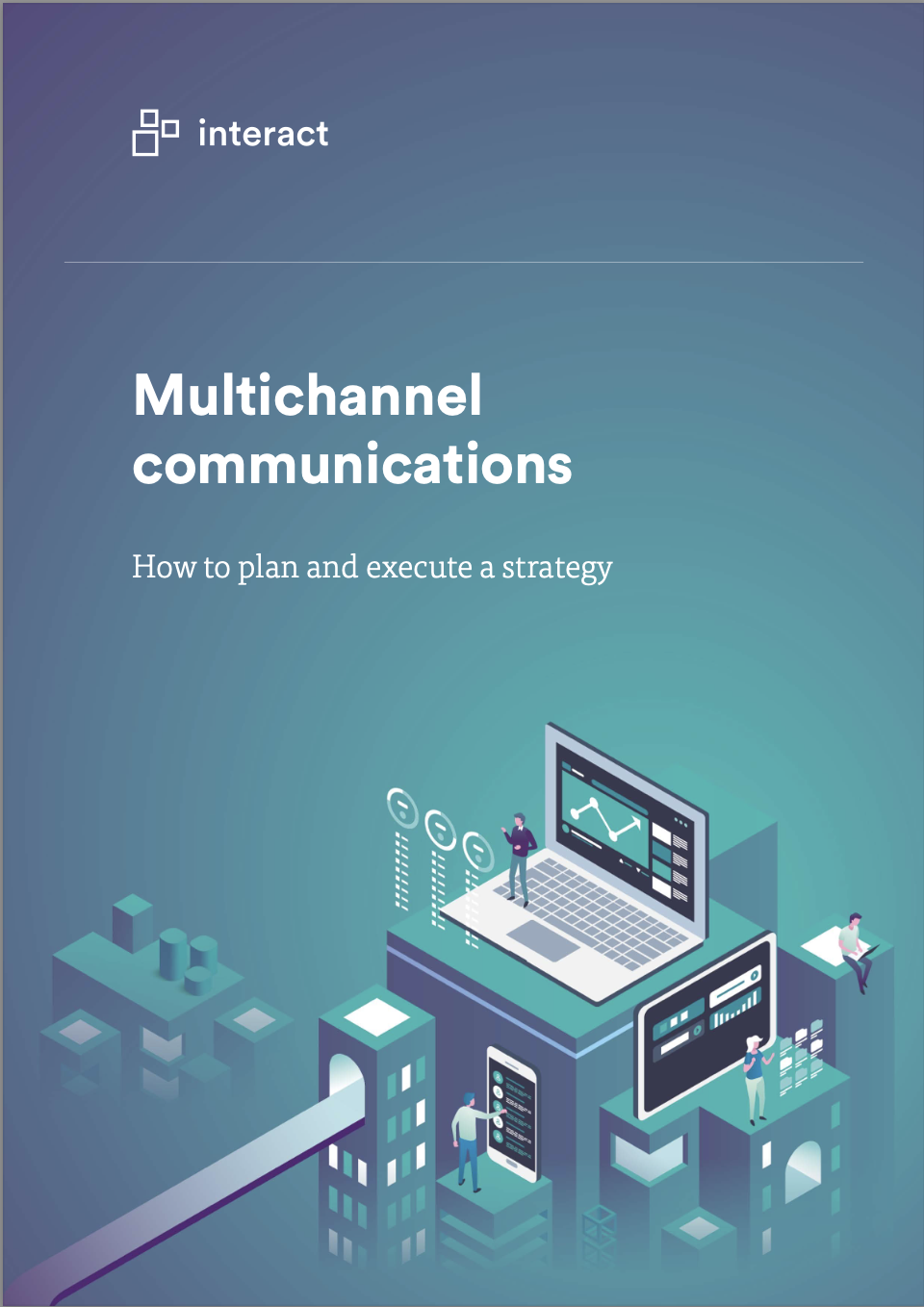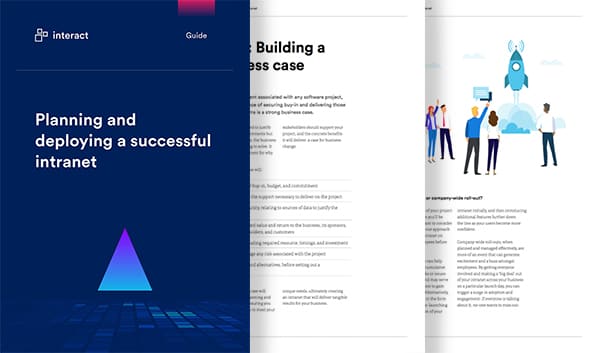Employee experience (EX) has never been more important, so when it comes to choosing the right employee experience technology, enterprises need to understand what to look out for. This article will guide you through the essential features any worthy EX platform should include.
A modern intranet is a holistic employee experience platform that is designed to bring your workforce together, no matter how dispersed it might be. When it comes to getting an intranet project off the ground though, there are many factors to consider. From ensuring your chosen EXP provides the right mix of comms tools and channels for your enterprise, to working out the potential ROI of an intranet you can deliver through the project, there is plenty to think about.
Finding digital employee experience technology with the right set of features for your organization will make this journey much easier, so here are a few of the essential features that we recommend you look out for in a modern enterprise-grade EXP.
1. UX that makes everything easy for everyone

From intranet managers to content authors and employee users, you want to make certain that your EXP has an easy, intuitive, and enjoyable user experience (UX).
Your chosen platform should provide flexibility for users to engage with content via desktop and responsive experiences as well as in native mobile apps. At a granular level, content can be deliberately configured so that responsive views are rendered in a desktop format, thus improving the overall experience of viewing the user interface (UI).
On the mobile app, layout and content selection should be controllable by intranet managers (e.g., horizontal or vertical scrolling of content). Mobile apps should also have MDM/MAM (e.g., MobileIron, Microsoft Intune) distribution options and should offer the ability for organizations to customize design in line with house styles. This can increase brand recognition for users.
Multichannel communications: How to plan and execute a strategy
Your employees should also be able to access intranet content and internal communications through apps such as Teams and Slack. The Interact platform, for example, can be accessed through the Teams app, which increases the ability to integrate all content and communications in one place.
Accessibility should be an essential consideration, so the right solution should align with the Web Content Accessibility Guidelines (WCAG) 2.1 level AA. Your chosen vendor should also be able to produce alternative themes as required (e.g., high contrast) to enhance your accessibility options.
2. Multichannel capabilities to reach every employee

Reaching employees in dispersed locations, as well as in different time zones and languages, is a historic challenge for internal communicators. To overcome this, modern intranets now include multichannel messaging as standard. In addition to publishing desktop and mobile content via the CMS intranet, admins should be able to use the same hub to communicate updates about these and other events with employees.
Audience segmentation should be extremely granular, meaning communications can be sent to the entire organization, to individuals, or to defined groups. Interact’s Personas feature allows administrators to create dynamic groups (e.g., all managers in NYC who started in the previous six months), based on employee metadata and without involving IT.
The multichannel options for communicating with the organization or individuals may include:
- Homepage lockout (pop-up with acknowledgement tracking on desktop/native apps)
- Homepage banners (desktop/native apps)
- SMS
- Employee email newsletter templates
- Slack and Teams (push into channels)
- Digital signage
Another way of ensuring that content reaches every employee is through the configuration of user homepages. Parts of each homepage can be targeted to different audiences so that they see different content based on their position in the organization. This is especially useful for communicating with different locations and levels of seniority. If you need to instruct managers only on how to deal with a situation involving their direct reports, this is a popular solution that avoids the need to send out multiple emails directing people to a range of different content.
3. AI intranet capabilties

Any worthy modern intranet should include AI capabilties to provide a variety of benefits. Interact utilizes AI to provide intranet users and managers with elevated experiences, from content generation, to personalization, delivery of communications, and knowledge accessibility:
Generative AI
Allows distributed authors (often separated by language, brand, and communications skill level) to write prompts or bullet points into the Interact AI assist box and the system will automatically draft an intranet article that fits the specifications.
AI in intranet content creation (as part of intuitive CMS intranet editor):
Sentiment and inclusivity analysis: AI-powered content analysis suggests improvements to content as authors are writing it, providing more positive and inclusive wording suggestions.
Improve: Interact AI can suggest more positive, casual, straightforward, confident, or friendly edits to existing content, a significant assist to the infrequent contributor.
Shorten or expand content: When space is at a premium or a more detailed explanation is needed, Interact AI can help lengthen or shorten content to fit the given format.
Simplify: Interact AI will help remove unnecessary words or overly complex concepts, ensuring your message is understandable and accessible to a wide audience.
Migrate content: Interact AI makes it easy to auto-adjust lengthy historical policies/procedures from incumbent intranets into a modern alternative.
Duplication detection: AI recognition spots similar content to avoid replication.
Auto summary: AI automatically populates the summary section of the content to improve findability.
Image accessibility: Automated AI-powered alternative text for images.
Communication delivery:
Interact AI analyzes historical, demographic, and psychographic data to optimize the delivery of communications, choosing the best channels to smartly schedule and publish on (including email, SMS, Slack, MS Teams, and digital signage), guaranteeing reach and engagement.
Personalization:
AI optimizes search result relevancy and automatically tailors content recommendations based on individual behaviors, interactions, and past digital footprints.
Knowledge accessibility:
Interact AI drives awareness and understanding by making content engaging and interactive. Shorten, expand, explain, or simplify internal content for diverse audiences. Use auto-generated quizzes for professional development or compliance, and instantly craft FAQs to concisely address employee queries.
Multichannel communications: How to plan and execute a strategy
4. Powerful enterprise search

All organizations store resources that employees need to do their jobs. From HR policies to product information, a company intranet should be a well organized repository that workers use to find up-to-date, authoritative material.
You want your employees to find content easily, so your chosen digital employee experience technology should allow metadata to be embedded in published content using variables including Topics, Tagging, Categories, Classification, Confidentiality Rating, Date Published, Date of Expiry, Review Date, Author, Owner, Title, and Summary. Users should also be able to suggest missing keywords to authors to support discovery.
All of these tools improve content discoverability, particularly when seen through the lens of a search tool like Interact’s Enterprise Search. The metadata embedded into content supports the intranet search tool so that it can order results by relevance. Metadata also improves the discoverability of related content by providing AI-driven recommendations.
For administrators, metadata is used heavily in content lifecycle management. The metadata added to content can be used to issue automated warnings on content retention and review as well as other reports (e.g., expired pages by Authors). These alerts enable admins to take action and keep content fresh and relevant. Within our new CMS editor, metadata is automatically applied using AI-based signals.
Multichannel communications: How to plan and execute a strategy
Interact’s Enterprise Search uses full text, metadata, and tags for a multi-faceted experience that surfaces relevant content for users. The search tool scans data in over 18 media types – including images, pdfs, and html. Search results can also be tailored to end-user activities such as previous searches, device, and location. This all ensures that search results are relevant for each user.
To further strengthen global access to your resources, multilingual search is supported across more than 60 non-English language indexes.
Finally, an effective intranet search tool must integrate with third-party repositories such as SharePoint, OneDrive, Box, and Google Drive for a single-search experience that covers all documents right across your organization.
5. Personalization
Every employee has their own individual needs and preferences when it comes to how they interact with employee experience technology.
Personalization features within an EXP can enhance productivity by allowing tools and experiences to be customized based on individual employees’ behaviours and preferences. An EXP that enables this, such as a modern intranet, can help to ensure that the platform is more engaging to use and employees’ interactions and workflows are more efficient and satisfactory.
As I mentioned earlier, an Interact intranet can provide personalized experiences using AI, helping each employee to see content that is relevant to their role, department, location, and content preferences. Employees may also subscribe to content from colleagues and intranet authors who interest them.
Intranet geofences are another method for increasing personalization, providing employees with content that is relevant to their precise location, and changing the content they see if they enter a different geofenced location, such as an office in another region, or a different branch, facility, or store.
Other important considerations
When it comes to choosing the right holistic EXP, it’s important to check that the vendors on your shortlist can demonstrate how they have added value for a variety of other enterprises, and that their software offers integrations and interoperability with content repositories, enterprise applications, and other business-suite products.
We hope this has given you plenty to think about when it comes to choosing the best EXP for enhancing your employee experience and improving communication across your enterprise.



